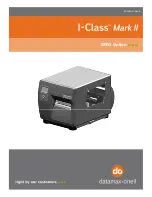
13
The shadow areas look grainy but the rest of
the print it OK
The effect, often referred to as ‘coalescence’, refers to
the way in which the ink is absorbed into the media.
Several things can be done to counter it, the most
important is to choose the correct print mode in the
printer driver. In general terms the highest quality
settings available will give the best results. Choose the
highest resolution possible, the finest drop size possible
and the highest quality media.
The image appears speckled
‘Mottling’ is due to uneven ink density on the sheet and
can be caused by: Poor paper formation, poor coating
coverage or drying. When using pigmented inks
improper ink absorption or binding can cause ‘rub off’.
The media takes too long to dry
The time taken for a print to dry depends on several
factors, i.e. The printer, ink and ink coverage. The
amount of ink printed which in turn depends on the
density of the image. Photographic and graphical images
use much more ink than text. Check your printer
settings to avoid the use of to much ink for the image.
The temperature and humidity of the room and the
amount of air movement also play an important role in
determining how long a print needs to dry. High humidity
will slow down the drying process. Inkjet media is
designed to work best in environmental conditions
ranging from 20ºC to 28ºC and 30% to 70% humidity.
For the best results carefully remove the print from the
printer once it had finished printing and place it flat in a
warm dry environment with good air circulation.
Normally a print will dry in several minutes, however if
you plan to print on the back it is advisable to wait a
couple of hours.
Sheets stick together when they collect in the output
tray of the printer.
Check you printer setting to avoid the use of too much
ink, avoid having multiple prints landing on each other,
remove the print once finished and place it elsewhere to
dry for several minutes
The sheet is not flat after drying
Too much ink has been used causing curl, check you are
using the correct material and if you have used the
correct printer settings.
Unprinted material sticks together
Working or storage conditions for relative humidity are
important. See your paper instructions for the optimum
storage conditions.
The paper won’t load into the printer
Check that the driver is not set to manual loading.
Ensure the paper is flat and not creased, that there is
nothing obstructing the paper entering the printer such
as tears etc. Ensure the paper is correctly positioned on
the media tray. Try feeding the paper manually, one
sheet at a time or using a different media tray.
It takes a long time before it prints
Photo and graphical images can be very large files and
take longer to process, be patient and see if it works
eventually. If it is just slow this might indicate that you
need more memory, or are running low on disk space.
Trying to do other tasks in parallel will slow the machine
down. Shut down all other applications and try again.
My printer doesn’t print
Check that everything is turned on and that all cables
are attached correctly, if possible use the driver to
perform a communication test with the printer. Try
printing a test page from the driver. If all of this works,
try printing using a different application. E.g. a word-
processing package to check the printer/computer
communication. Finally, try printing a small image (most
packages have tutorial or sample images which are
small files), the image may be too complex for your
computer and printer to handle. Try printing the
document without the image to see if this is the case. If
so, reduce the resolution of the graphics as the higher
the resolution the more memory and time the process
will take. If you are printing several graphical pages or
pages with heavy formatting try to print just one or two
pages at a time.
The printer loads more than one sheet at once
Try putting fewer sheets in the tray and fanning them
before loading them, if this fails then try loading them
manually one sheet at a time.
Properties
Key factors to achieving:
Sharpness
Uniform and circular dots, exact placement,
controlled dot gain
Contrast
Minimal ink penetration into substrate,
controlled dot gain
Properties
Key factors to avoiding:
Mottling
Homogeneous paper, uniform distribution of
fibres and fillers
Ink bleed
Rapid drying through good and even ink
absorption
Factors Influencing Image Quality






































